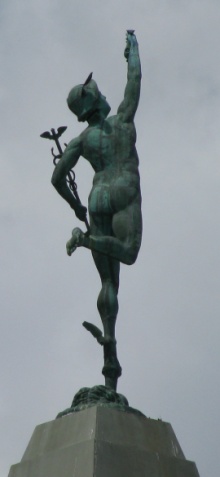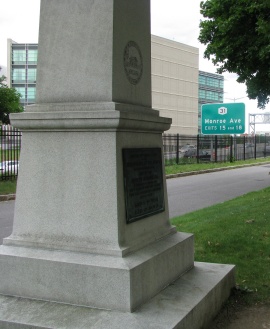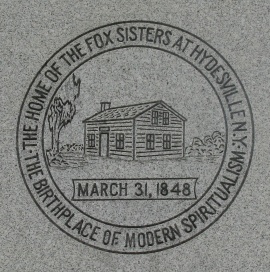
At the conclusion of the previous post I made an observation that seems to validate the esoteric interpretation of Plutarch's description of voyages, that the Great Lakes area had been visited by the ancient Greeks who somehow set it apart for a future people and purpose. The modern Greek state was first recognized in 1828 and established in 1830, following the successful uprising against Ottoman rule that had begun in 1821. At that very time, towns and villages in Upstate New York had been springing forth bearing the names of the cities, city/states and islands of ancient Greece. This phenomenon might easily be dismissed as a meaningless trend, as most are prone to do, but taken in the context of the supernaturalism featured in this blog series it appears to be further evidence of the influence of the ancient gods that is attested to perhaps most evidently by the statue of Hermes exalted over the city of Rochester, NY.

(Click the image to see a larger version)
To understand what Y'shua, the revealer of secrets, is opening to us about these matters it's necessary to find the right "dots" and rightly connect them, so we get the picture. If what is drawn looks like the work of Picasso, we don't yet have it right. When the drawing becomes more and more plain and details are filling in according to the exact patterns revealed elsewhere, we know we're getting it right, and that the Lord is fulfilling His word to us, who need this confidence in discerning His plan in this critical season.
Luke 8:17
The namesake of the town of Gates offers a remarkable witness.
The Town of Greece that is now a contiguous suburb of Rochester was established in 1822. Rochester was established with the name of Rochester a year later, in 1823, the most significant year in the development of the Erie canal, a waterway that is so tightly bound to Rochester's identity, growth and influence. Both Greece and Rochester were brought forth from out of Gates. Give some thought to what that suggests. Consider it as a parable.
That both Greece and Rochester emerged from Gates speaks to me of how "The area was anciently set apart for coming generations in the great human experiment of the democratic commonwealth." (The Secret Destiny of America) Whatever gates or inter-dimensional portals exist in the area must have been established by the ancient Greeks of record, quite possibly demi-gods or the gods themselves who were declared to dwell upon the heights of Mount Olympus. By way of these supernatural gates, the region is bound to the ancient gods and so dedicated to their worship and service! Doesn't this offer a fit explanation for the landmarks, objects and events addressed in this series?
The namesake of the city of Rochester reveals yet another parable. Here's one account of the city's origins, from History of Rochester, New York - Wikipedia.
Enoch 15:9-10
The Jinni

There is a class of beings associated with caves, the jinn. The jinn, or, djinn, are also known as genies, and one singular jinn is a jinni. Rochester is widely known for its Genny (Genesee Brewing Company beers and ales) and its Jenny, an early biplane designed and built by Glenn Curtiss in nearby Hammondsport! Although most will see no connection between the jinni, Genny and Jenny beyond merely sounding alike, there may well be a supernatural reason for Rochester's linguistic identification with jinni.
The legendary jinni is a supernatural creature that occupies a parallel world to that of mankind. According to the Occultopedia "Jinn" page, the fallen Watcher Azazel was a Jinn. The jinn are mentioned frequently in the Qur’an. The people of Oman believe jinn live in their caves. The winged genie is a motif in the Iron Age art of Assyria. Some popular literary works involving these creatures are One Thousand and One Nights and The Fisherman and the Jinni, plus there are spin-off productions like Disney's Aladdin.
(The Basque People)

Interpreting the parable of "Nathaniel Rochester" suggests the stone fortress is somehow a gift of God or a god, or both. Given how Rochester has in times past been renowned for great good and great evil, it seems to me that this region may become a refuge for a protected people in days to come, servants of the Most High God. I can't say with authority at the present time that Rochester truly is a stone camp or fortress of one kind or the other, or, for that matter, of both kinds or neither. The circumstantial evidence and what insight I believe I have received thus far suggests that Rochester is involved as a significant Mystery Babylon location and that it's a gateway used by the ancient gods, and that it's somehow related to the binding and loosing of Nephilim by way of the supernaturalism of magickal ritual from ancient times past. Are fallen angels akin to Azazel dwelling in some kind of subterranean stone fortress in Upstate New York? If so, it will soon enough be manifest.
New York resembles Greece

(Click the image to see a larger version)
At this point, I'm going to offer a survey of some of the local communities that bear the names of ancient Greece. Before I conclude, I'm going to show how Hermes is further revealed in this as the god or prince of Rochester. Notice how these (excepting Corfu and Arcade) were established just prior to 1830, when the modern state of Greece was recognized.
Corfu, NY (50 miles WSW of Rochester) is a village named after the Island of Corfu that was incorporated in 1868.
Arcade, NY (74 miles SW of Rochester) was established in 1807 as the "Town of China." The name changed to Arcade in 1866.
I was raised in Macedon, NY (20 miles ESE of Rochester), named after the ancient kingdom of Macedon (also known as Macedonia) in northern Greece. This was the birthplace of Alexander the Great. The namesake for the region was Makedon(Macedon), a mortal demi-god who, according to Hesiod the poet, was a son of Zeus and Thyia. The first officially recognized settlers arrived in 1789, and it was established as Macedon in the same year Rochester was officially established, 1823. Macedon, NY is a canal town, formed out of the nearby canal town of Palmyra.
Palmyra, NY (24 miles ESE of Rochester, established under this name in 1796) was named after an ancient city in Syria. Although that city isn't generally associated with the Greek Empire, it does bear features that distinctly point to the worship of the Greek gods. "The most striking building in Palmyra is the huge temple of Ba'al, considered "the most important religious building of the first century AD in the Middle East". It originated as a Hellenistic temple, of which only fragments of stones survive. The central shrine (cella) was added in the early 1st century AD, followed by a large double colonnaded portico in Corynthian style." (Palmyra - Wikipedia) Just south of Palmyra, NY, the Joseph Smith farm and the Hill Cumorah are found. A statue of the "Angel Moroni" is on top of that hill, as an exalted subregent.
The city of Syracuse, NY (87 miles E) is the largest city in Central New York. Another canal town, its namesake is the Greek city and province on the island of Sicily in southern Italy. Ancient Syracuse was founded by Corinthians, and allied with Sparta and Corinth. In ancient Corinth, honor was particularly given to Aphrodite, Apollo, Poseidon and Zeus, and, in ancient Syracuse, to Apollo and Zeus. Syracuse, NY had been known by several names before being officially incorporated in 1825. It was Corinth in 1817, but the name was changed when the US Postal Service rejected their application for a post office. A Corinth, NY Post Office had already been established in 1818 in Saratoga County.
Ithaca, NY (90 miles SE) is named for the Greek island. The village was incorporated in 1821, distinguished from its parent town of Ulysses, the Latinized form of the Greek Odysseus from Homer's Odyssey. According to legend, the ancient Ithaca was home to Odysseus and his wife Penelope. Penelope, according to some accounts, later bore a son with Hermes in Arcadia.
Ithaca is notably different in character politically (left-wing) and culturally from surrounding communities. The following are mostly as extracted from Wikipedia. Ithaca is host to the Namgyal Monastery, the North American seat of Tenzin Gyatso, the 14th Dalai Lama. Ithaca is commonly listed among the most culturally liberal of American small cities. The Utne Reader named Ithaca "America's most enlightened town" in 1997. According to ePodunk's Gay Index, Ithaca has a score of 231, versus a national average score of 100. In its earliest years during frontier days, what is now Ithaca was briefly known by the names "The Flats" and "Sodom," the name of the Biblical city of sin, due to its reputation as a town of "notorious immorality". Nearby Robert H. Treman State Park features Lucifer Falls. The Ivy League Cornell University's early nickname was "the godless university," due at least in part to their lack of affiliation with organized religion.
Troy, NY (230 miles E) is on the Hudson River, a natural part of what became the great canal system. Troy was named in 1789 for the famous home of the Trojans of Greece, where lived the legendary beauty, Helen.
Athens, NY (255 miles ESE) as a village was incorporated in 1805, and as a town formed in 1815. Like Troy, it's on the Hudson River. A now defunct ferry was portrayed in the 2005 film "War of the Worlds," when alien Martian tripods attack the town and ferry with its refugees from New York City attempting to flee across the Hudson.
Sparta, NY (45 miles S) was established in 1789. It's not on the canal system.
Attica, NY (47 miles SW) as a town was established in 1811, and as a village was incorporated in 1837. It was named for the region in Greece that contains its capitol city, Athens. Like Corfu and Sparta, it's not on the canal system. The Attica Correctional Facility is famous for the deadly prison riot of September 13, 1971.

Arcadia, NY (34 miles ESE) is perhaps the most interesting of the Greek named cities, towns and villages listed here. The Zurich Bog is the lowest point in the town and a registered national landmark. It was known to the natives as the "Bottomless Pit." It has been recorded that Hermes was born at Mount Kyllene (Cyllene) in Arkadia (Arcadia). It is also recorded that Hermes learned from the Thriae the arts of fortune-telling and divination. In 1848, in the town of Arcadia, NY on Hydesville Road, the Fox sisters introduced in America what is known as Spiritualism. Note that it was from a place known as Hydesville, like "hides"-ville, that unseen forces were declared to be brought forth from the hidden realm, and this was actually a deception, hiding the true nature of the activity.
 Hermes is also known as a trickster, and many years later the Fox sisters confessed to the fraudulent nature of their activity. (Our day: a record and review of current reform, Volume 2 edited by Joseph Cook, Hazlitt Alva Cuppy) Margaret Fox (Kane) and her sister Kate admitted fraud, yet there really are authentic mediums (including the biblical witch of Endor plus Jane Roberts (who channeled "Seth") and Chip Coffee, both of Elmira, NY).
Hermes is also known as a trickster, and many years later the Fox sisters confessed to the fraudulent nature of their activity. (Our day: a record and review of current reform, Volume 2 edited by Joseph Cook, Hazlitt Alva Cuppy) Margaret Fox (Kane) and her sister Kate admitted fraud, yet there really are authentic mediums (including the biblical witch of Endor plus Jane Roberts (who channeled "Seth") and Chip Coffee, both of Elmira, NY). The area was first settled around 1791. The Town of Arcadia was formed from the Town of Lyons in 1825. More weirdness came forth in 1986 from Lyons and other locations around the county when a horror movie was filmed popularizing a local legend, the Lady in White. I remember hearing tales of the lady in white when I was in High School.
The compilation of facts, no matter how extensive or relevant will never convince the blind of anything, but those who recognize the artifacts of supernaturalism may perceive the influence of the ancient gods in the region. What Rochester was, is and will be seems quite significant.
More coming, Lord willing!

I just want to thank you. As a lifetime rochester that has viewed these land marks and such so many times, it great to get this occult view. I think i am going to have to plan a field trip next weekend to visit some and view them from a new perspective
ReplyDeleteYou're welcome. You'll find plenty there to explore!
ReplyDelete